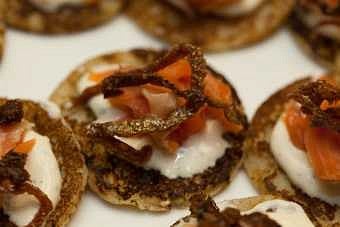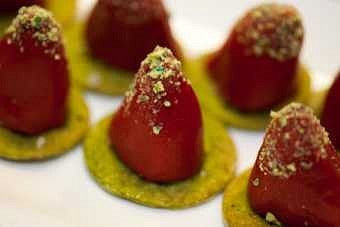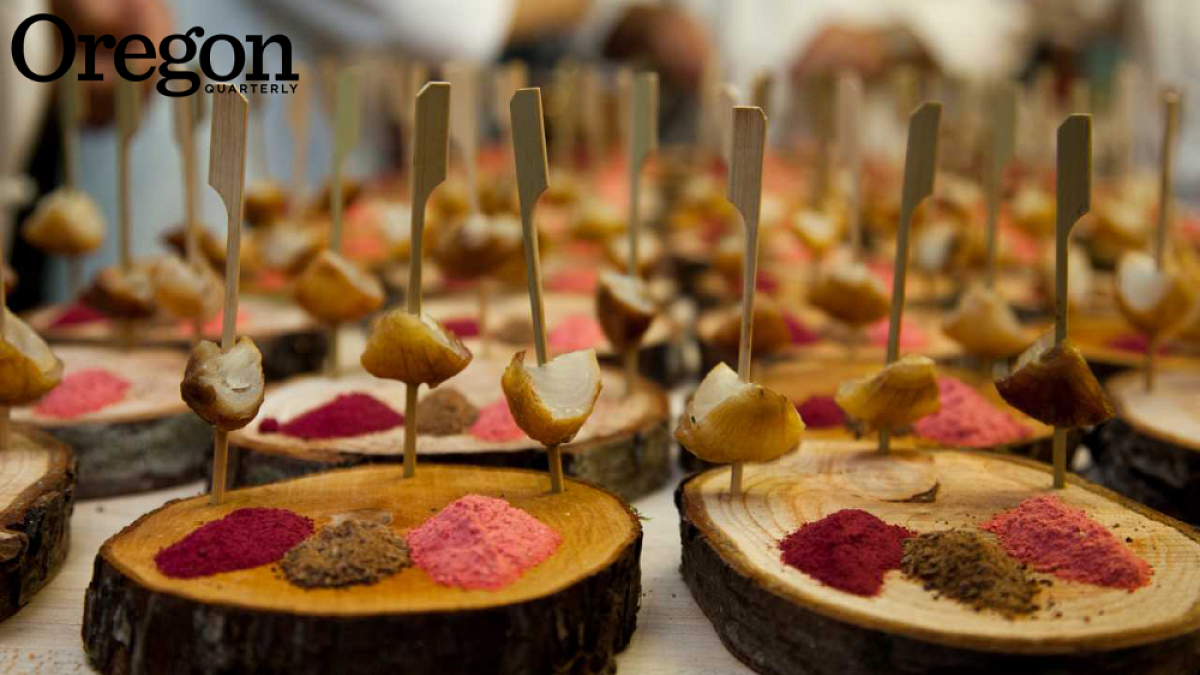It’s a balmy autumn evening in Greenwich Village, and at the James Beard House on West 12th Street, one of Oregon’s finest chefs is setting out a plate of hot-and-cold smoked steelhead appetizers—morsels of pink fish resting on a dollop of yerba buena–infused crème fraîche and set atop little pancakes made with baked camas. “Blini with lox,” he quips to a curious guest who, wine glass in hand, pauses to observe the preparations.

The dinner this night—September 30, 2011—is something new for the James Beard House as well. The four-story brownstone where Oregon native James Beard cooked and taught and wrote for twenty-six years is now, among other things, a performance space for guest chefs from throughout the United States and occasionally beyond—“the rising stars and those who have already risen and those who you can’t believe are still around,” as director of house programming Izabela Wojcik puts it. They come to show off the best of what’s cooking in their own restaurants and regions. But never before has a chef attempted to showcase what is arguably the most American food of all: the staples of a particular Native American tribe.
Staples such as wild steelhead. “What’s that?” Wojcik had asked last spring when Bennett first called to sketch out his proposed menu. Beard himself would not have had to ask; he grew up in Portland and spent summers in Gearhart, eating and learning to cook the fish and shellfish, wild and cultivated fruits and vegetables of his home state. The cakes under the steelhead in Bennett’s appetizer were made of camas bulbs dug west of Albany, and the crème fraîche on top was flavored with yerba buena, a member of the mint family that grows wild throughout the Pacific Northwest. Bennett smoked the steelhead in Oregon using a technique he hoped would both honor the Kalapuya way with fish and please Easterners accustomed to cold-smoked salmon, laying the steelhead on blocks of ice while it smoked.



It was a reasonable question. Bennett had cooked there once before, three years earlier—a “Taste of the Willamette Valley,” he called the menu, with dishes such as lamb with chanterelles and heirloom carrots, gathered greens with crab apple vinaigrette, and Oregon black truffle ice cream—and so was known to the Beard House staff. In fact, just two months before the April dinner, the Beard Foundation had named Bennett a semifinalist for 2011 Best Chef: Northwest, an honor bestowed on only twenty chefs from six Northwest states. Bennett was the only Oregon chef from outside of Portland to make the list.
Which may be why the Beard House was willing to give the Kalapuya menu a go. Wojcik had been approached previously by people interested in bringing an expert on Native American foodstuffs to the House. But knowledge, she explains, is not enough. “Ultimately you have to have the chops, the backing of your staff, and be able to come here and feed fifty, sixty, seventy people. That’s not for someone who writes cookbooks or lectures on food.” The meal Bennett proposed was not a historical meal—a recreation of what might have been eaten in a plank house 200 or 2,000 years ago. Rather, as Wojcik explains it, “He’s examining the traditional preparations, trying to bridge the gap between how those native people would have cooked and how a chef today cooks, to make it appealing to a contemporary diner. It’s unique that way.”
But being unique, or even merely interesting, is also not enough to pull off a dinner like this. Particularly for a chef without a television presence, whose celebrity is mostly limited to Linn and Benton Counties, it’s not easy to tantalize enough New Yorkers. Even if you do fill the dining room, with patrons paying $170 a plate, such a dinner typically doesn’t pencil out for a chef—not after flying his team of four to New York and putting them up for three nights. Definitely not when nearly all the foods have been caught, gathered, picked, or dug by hand in swamps and fields and forests 2,500 miles away and packed into six large coolers checked as luggage on the flight out.

Tom was immediately enthusiastic; she went on to champion Bennett to the Tribal Council, which awarded him funding to help make the Beard House meal possible. “One of the things all tribes struggle with is recognition—you have to be out there telling your story,” Tom says. “Times have changed. These different kinds of venues offer us an opportunity to tell our story, and to correct the story.”
Lewis, too, was supportive. His work focuses more on the tribes’ educational programs, particularly the teaching of Chinook Wawa, the trade language that this disparate collection of tribes from throughout the Northwest used to communicate after being thrown together on a reservation in the middle of the Willlamette Valley in the 1850s. But revival of food traditions is another aspect of the cultural renaissance the tribes are pursuing and Lewis is helping to guide. He and Archuleta talked at length with Bennett about camas bulbs, traditionally a major source of carbohydrates for Northwest Indians, requiring a day or more of baking to be edible, and about wapato tubers, which Indians roast like potatoes after harvesting them from riverside swamps. Habitats for both plants, once abundant, have shrunk to a fraction of what they were prior to white settlement. It was Archuleta who recommended Bennett bake camas bulbs in a crock pot—the modern corollary to the earthen ovens the Kalapuya themselves used to use.
“I kind of picked everybody’s brains,” Bennett recalls of that meeting. He wanted to find what he called the lutefisks—“foods you ate as a kid that maybe your grandparents served and you ate and enjoyed but would never eat on your own. I wanted to work with those products and make them fun.”
He also wanted to learn more about the Kalapuya people and the tribes in general, and Lewis was happy to oblige; his UO doctoral dissertation focused on the 1954 termination of the Confederated Tribes of Grand Ronde. A decade-long effort to restore federal recognition met with success in 1983. Since then the tribes have experienced a profound change of fortunes. Their language and cultural traditions are being revived. And the overwhelming poverty that once characterized the reservation is gradually fading. Proceeds from the tribes’ Spirit Mountain Casino provide not only health care, education, and other benefits to tribal members but have funded, as of the end of 2011, grants totaling more than $55 million to a wide range of nonprofit organizations throughout western Oregon.
A few families still eat wapato and camas as a regular part of their diet, Lewis says—“it’s not as uncommon as you might think.” Camas is almost a sacrament for modern Indians in Oregon, eaten as much for spiritual renewal as bodily nourishment. Plenty of people hunt for elk and deer, and fish for salmon and eel. “And we all love huckleberries,” he says, adding that many tribal members still pack up the family in late summer and head to their traditional berrying grounds high in the Cascades for a weekend of huckleberry picking just as their ancestors did, although RVs and tents often stand in for tepees. It’s a little like Bennett’s approach to Kalapuya foods, both honoring and tweaking tradition. “It’s a new configuration,” Lewis says of Bennett’s menu. “It’s going to fit the modern palate. Maybe he can revitalize an interest in native foods. And that’s a healthy thing.”
* * *

Tom has traveled to New York to represent the tribes at the dinner and to help bridge the gap, with her presence, between past and present, as Bennett is attempting with his menu. She is a striking woman, more so with her necklaces of white dentalia shells and large beaded medallion and beaded earrings. Now she takes in the scene—a full house of diners poised to savor the traditional foods of her people, reconfigured, and gazing down from the wall, that icon of American cuisine, James Beard himself.
“I’d like to say a few words,” Tom begins, beaming. “We didn’t eat food like this when I was a child. But I wish we had!”
—By Bonnie Henderson
Bonnie Henderson ’79, MA ’85, a Eugene writer, is the author of Strand: An Odyssey of Pacific Ocean Debris, a finalist for the 2009 Oregon Book Awards. Her last feature for Oregon Quarterly was “Beaver Believers” (Spring 2011).
Photographs by Krishna Dayanidhi


